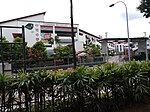Kuo Chuan Presbyterian Secondary School (KCPSS) is a co-educational government-aided secondary school located in Bishan, Singapore.
History:
In 1924, two Christian Ministers, the Reverend Tay Sek Tin and the Reverend Tan Leng Tian, who saw the need to provide a school which would also serve as an evangelistic centre, founded Katong Girls' School at 1 Joo Chiat Terrace. It had a modest enrolment of 11 pupils, both boys and girls. English and Chinese classes were conducted.
By 1925, the school moved to new premises at Koon Seng Road and was named Choon Guan School. In 1934, Miss Margaret Dryburgh was appointed Principal. Educational standards were raised and in 1936 the English section became a separate school called Choon Guan English School. In 1938, it became a 'grant-in-aid' for boys and Mr J R Richardson became the principal.
As a result, the same year, a school for girls, called Kuo Chuan Girls' School, was opened at 36 Joo Chiat Lane with Miss Margaret Dryburgh as principal. It had one hundred girls and three teachers. During the Japanese Occupation, the school was bombed and remained closed for the duration of the war while the boys' school became a Japanese school named Koon Seng Road School.
Nineteen days after the end of the Japanese Occupation, on 24th September 1945, the boys' school reopened, once again with Mr Richardson as Principal. To accommodate those who could not gain admission, Dryburgh English School was established as an afternoon school. The girls' school did not open until the next year and Miss Monica Sirkett arrived from England in 1947 as Principal.
Meanwhile, the boys' school was making rapid progress and in 1949 the first group of students sat for the Cambridge School Cambridge Certificate Examination. The next year, the school was renamed Presbyterian Boys' School. In 1951, Mr. B F Atherton arrived to take over as Principal and when he left in 1958, Mr. Gay Wan Guay succeeded him.
Progress was also being made in the girls' school. It became a full government-aided school in 1951 and two years later, the first group of students sat for the Cambridge Examination .In line with government policy, Dryburgh English School was merged with Presbyterian Boys' School under Mr Sia Kah Hui who served as principal from 1961 to 1963. Succeeding principals were Mr Wee Choon Siang. Mr Poon Meng Seng, Mr Tan Choong Yan and two Acting Principals.
In 1970, the schools' sense of identity was given a boost with the adoption of a school anthem. The words were derived from a competition among the staff and students of Presbyterian Boys' School while Mr Samuel Ting Chu San specially wrote the music.
In 1972, Miss Sirkett retired after twenty-five years of tireless, fruitful and dedicated service. Succeeding Principals were Mrs Lee Choon Neo from 1972 to 1977, Mrs Mabel Lew from 1978 to 1983 and Madam Kang Swee Chin from 1984 to 1990.
The two schools reached another important milestone when in 1985 they were amalgamated into one co-educational full school called Kuo Chuan Presbyterian Secondary School. As the school buildings and facilities had become increasingly inadequate, the next year, the Ministry of Education allocated a new site at Bishan Street 13 to the school. In 1987, the full school developed into two schools, named Kuo Chuan Presbyterian Primary School, headed by Mrs Goh Soo Sim, and Kuo Chuan Presbyterian Secondary School, which continued to be headed by Madam Kang. The Primary School moved to its present site in November 1987 while the secondary school was relocated in June the next year. In January 1991, Mr Low Eng Kee succeeded Madam Kang as principal.




